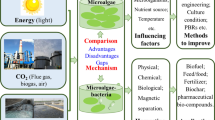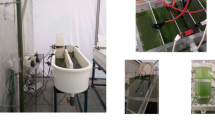Abstract
The concentration of carbon dioxide (CO2) in the atmosphere has increased from 280 to 400 ppm in the last 10 years, and the coal-fired power plants are responsible for approximately 22 % of these emissions. The burning of fossil fuel also produces a great amount of solid waste that causes serious industrial and environmental problems. The biological processes become interesting alternative in combating pollution and develo** new products. The objective of this study was to evaluate the CO2 biofixation potential of microalgae that were grown using gaseous effluents and solid residues of thermoelectric origin. The microalgae Chlorella fusca LEB 111 presented higher rate of CO2 biofixation (42.8 %) (p < 0.01) than did Spirulina sp. LEB 18. The values for the CO2 biofixation rates and the kinetic parameters of Spirulina and Chlorella cells grown using combustion gas did not differ significantly from those of cells grown using CO2 and a carbon source in the culture media. These microalgae could be grown using ash derived from coal combustion, using the minerals present in this residue as the source of the essential metals required for their growth and the CO2 derived from the combustion gas as their carbon source.

Similar content being viewed by others
References
Toledo-Cervantes, A., Morales, M., Novelo, E., & Revah, S. (2013). Carbon dioxide fixation and lipid storage by Scenedesmus obtusiusculus. Bioresource Technology, 130, 652–658.
Eletrobras, CGTEE. Companhia de geração térmica de energia elétrica. Available from: www.cgtee.gov.br. Accessed 22 September 2015.
Liu, G., Vassilev, S. V., Gao, L., Zheng, L., & Peng, Z. (2005). Mineral and chemical composition and some trace element contents in coals and coal ashes from Huaibei coal field, China. Energy Conversion and Management, 46, 2001–2009.
Bityukova, L., Mõtlep, R., & Kirsimäe, K. (2010). Composition of oil shale ashes from pulverized firing and circulating fluidized-bed boiler in Narva thermal power plants, Estonia. Oil Shale, 27, 339–353.
Chiu, S. Y., Kao, C. Y., Chen, C. H., Kuan, T. C., Ong, S. C., & Lin, C. S. (2008). Reduction of CO2 by a high-density culture of Chlorella sp. in a semicontinuous photobioreactor. Bioresource Technology, 99, 3389–3396.
Chiu, S. Y., Kao, C. Y., Tsai, M. T., Ong, S. C., Chen, C. H., & Lin, C. S. (2009). Lipid accumulation and CO2 utilization of Nannochloropsis oculata in response to CO2 aeration. Bioresource Technology, 100, 833–838.
Rosa, A. P. C., Carvalho, L. F., Goldbeck, L., & Costa, J. A. V. (2011). Carbon dioxide fixation by microalgae cultivated in open bioreactors. Energy Conversion and Management, 52, 3071–3073.
Flues, M., Sato, I. M., Scapin, M. A., Cotrim, M. E. B., & Camargo, I. M. C. (2013). Toxic elements mobility in coal and ashes of Figueira coal power plant, Brazil. Fuel, 103, 430–436.
Ctvrtnickova, T., Mateo, M. P., Yañez, A., & Nicolas, G. (2009). Characterization of coal fly ash components by laser-induced breakdown spectroscopy. Spectrochimica Acta Part B: Atomic Spectroscopy, 64, 1093–1097.
Antelo, F. S., Anschau, A., Costa, J. A. V., & Kalil, S. J. (2010). Extraction and purification of C-phycocyanin from Spirulina platensis in conventional and integrated aqueous two-phase systems. Journal of the Brazilian Chemical Society, 21, 921–926.
Chisti, Y. (2007). Biodiesel from microalgae. Biotechnology Advances, 25, 294–306.
Haase, S. M., Huchzermeyer, B., & Rath, T. (2012). PHB accumulation in Nostoc muscorum under different carbon stress situations. Journal of Applied Phycology, 24, 157–162.
Morais, M. G., Costa, J. A. V., Marins, L. F. F., Reichert, C. C., Dalcanton, F., & Durante, A. J. (2008). Isolation and characterization of a new Arthrospira strain. Zeitschrift für Naturforschung Section C, 63c, 144–150.
Zarrouk, C. (1966), Contribuition a letude cyanophycee, influence de divers facteurs physiques et chimiques sur la croissance et photosynthese de Spirulina maxima Geitler. University of Paris.
Rippka, R., Deruelles, J., Waterbury, J. W., Herdman, M., & Stanier, R. G. (1979). Genetic assignments, strain histories and properties of pure cultures of Cyanobacteria. Journal of General Microbiology, 111, 1–61.
Morais, M. G., & Costa, J. A. V. (2007). Biofixation of carbon dioxide by Spirulina sp. and Scenedesmus obliquus cultivated in a three-stage serial tubular photobioreactor. Journal of Biotechnology, 129, 439–445.
Reichert, C. C., Reinehr, C. O., & Costa, J. A. V. (2006). Semicontinuous cultivation of the cyanobacterium Spirulina platensis in a closed photobioreactor. Brazilian Journal of Chemical Engineering, 23, 23–28.
Radmann, E. M., Reinehr, C. O., & Costa, J. A. V. (2007). Optimization of the repeated batch cultivation of microalga Spirulina platensis in open raceway ponds. Aquaculture, 265, 118–126.
Baumgarten, M. G. Z., Wallner-Kersanach, M., & Niencheski, L. F. H. (2010). Manual de análises em oceanografia química (2nd ed.). Rio Grande: FURG. 172p.
Schmidell, W., Lima, A. U., Aquarone, E., & Borzani, W. (2001). Biotecnologia industrial. São Paulo: Edgard Blücher LTDA.
Bailey, J. E., & Ollis, D. F. (1986). Biochemical engineering fundamentals (2nd ed.). Singapore: McGraw-Hill.
Binaghi, L. D., Borghi, A., Lodi, A., Converti, A. D., & Borghi, M. (2003). Batch and fed-batch uptake of carbon dioxide by Spirulina platensis. Process Biochemistry, 38, 1341–1346.
Basu, S., Roy, A. S., Mohanty, K., & Ghoshal, A. K. (2013). Enhanced CO2 sequestration by a novel microalga: Scenedesmus obliquus SA1 isolated from bio-diversity hotspot region of Assam, India. Bioresource Technology, 143, 369–377.
Radmann, E. M., Camerini, F. V., Santos, T. D., & Costa, J. A. V. (2011). Isolation and application of SOX and NOX resistant microalgae in biofixation of CO2 from thermoelectricity plants. Energy Conversion and Management, 52, 3132–3136.
Pires, J. C. M., Alvim-Ferraz, M. C. M., Martins, F. G., & Simões, M. (2012). Carbon dioxide capture from flue gases using microalgae: engineering aspects and biorefinery concept. Renew and Sustainable Energy Reviews, 16, 3043–3053.
Brown, L. M. (1996). Uptake of carbon dioxide from flue gas by microalgae. Energy Conversion and Management, 37, 1363–1367.
Chu, W. L., Phang, S. M., & Goh, S. H. (1996). Environmental effects on growth and biochemical composition of Nitzschia inconspicua Grunow. Journal of Applied Phycology, 8, 389–396.
Renaud, S. M., Thinh, L. V., Lambridis, G., & Parry, D. L. (2002). Effect of temperature on growth, chemical composition and fatty acid composition of tropical Australian microalgae grown in batch cultures. Aquaculture, 211, 195–214.
Salih, F. M. (2011). Microalgae tolerance to high concentrations of carbon dioxide: a review. Journal of Environmental Protection, 2, 648–654.
Morais, M. G., & Costa, J. A. V. (2007). Isolation and selection of microalgae from coal fired thermoelectric power plant for biofixation of carbon dioxide. Energy Conversion and Management, 48, 2169–2173.
Tastan, B. E., Duygu, E., Atakol, O., & Donmez, G. (2012). SO2 and NO2 tolerance of microalgae with the help of some growth stimulators. Energy Conversion and Management, 64, 28–34.
Costa, J. A. V., Colla, L. M., Filho, P. D., Kabke, K., & Weber, A. (2002). Modelling of Spirulina platensis growth in fresh water using response surface methodology. World Journal of Microbiology and Biotechnology, 18, 603–607.
Vonshak, A. (1997). Spirulina platensis (Arthrospira): physiology, cell-biology and biotechnology. London: Taylor & Francis.
Soares, E. R., Mello, J. W. V., Schaefer, E. G. R., & Costa, L. M. (2006). Cinza e carbonato de cálcio na mitigação de drenagem ácida em estéril de mineração de carvão. Revista Brasileira de Ciência do Solo, 30, 171–181.
Sankar, V., Daniel, D. K., & Krastanov, A. (2011). Carbon dioxide fixation by Chlorella minutissima batch cultures in a stirred tank bioreactor. Biotechnology & Biotechnological Equipment, 25, 2468–2476.
Gadd, G. M. (2004). Microbial influence on metal mobility and application for bioremediation. Geoderma, 122, 109–119.
Singh, P., & Cameotra, S. S. (2004). Enhancement of metal bioremediation by use of microbial surfactants. Biochemical and Biophysical Research Communications, 319, 291–297.
Wang, L., Min, M., Li, Y., Chen, P., Chen, Y., & Liu, Y. (2010). Cultivation of green algae Chlorella sp. in different wastewaters from municipal wastewater treatment plant. Applied Biochemistry and Biotechnology, 162, 1174–1186.
Bender, J., Rodriguez-Eaton, S., Ekanemesang, U. M., & Phillips, P. (1994). Characterization of metal-binding bioflocculants produced by the cyanobacterial component of mixed microbial mats. Applied and Environmental Microbiology, 60, 2311–2315.
Fungaro, D. A., & Silva, M. G. (2002). Utilização de zeólita preparada a partir de cinzas residuárias de carvão como adsorvedor de metais em água. Quim Nova, 6, 1081–1085.
Acknowledgments
The authors would like to thank CNPq (National Council of Technological and Scientific Development) and CGTEE (Company of Thermal Generation of Electric Power) for their financial support of this study.
Author information
Authors and Affiliations
Corresponding author
Ethics declarations
Conflict of Interests
The authors declare that there is no conflict of interests regarding the publication of this paper.
Rights and permissions
About this article
Cite this article
da Silva Vaz, B., Costa, J.A.V. & de Morais, M.G. CO2 Biofixation by the Cyanobacterium Spirulina sp. LEB 18 and the Green Alga Chlorella fusca LEB 111 Grown Using Gas Effluents and Solid Residues of Thermoelectric Origin. Appl Biochem Biotechnol 178, 418–429 (2016). https://doi.org/10.1007/s12010-015-1876-8
Received:
Accepted:
Published:
Issue Date:
DOI: https://doi.org/10.1007/s12010-015-1876-8




